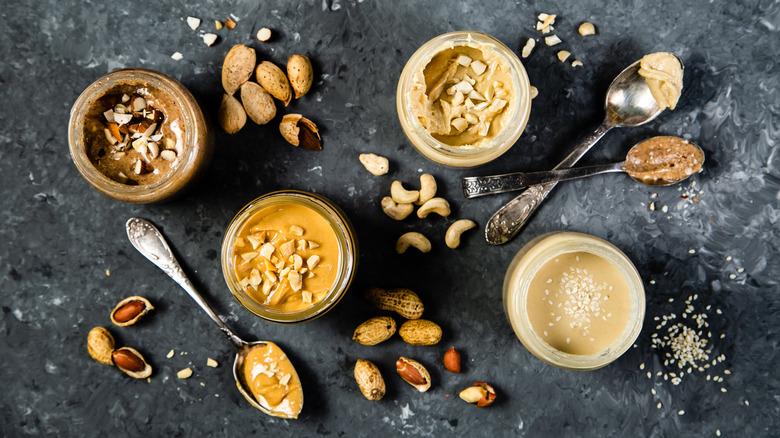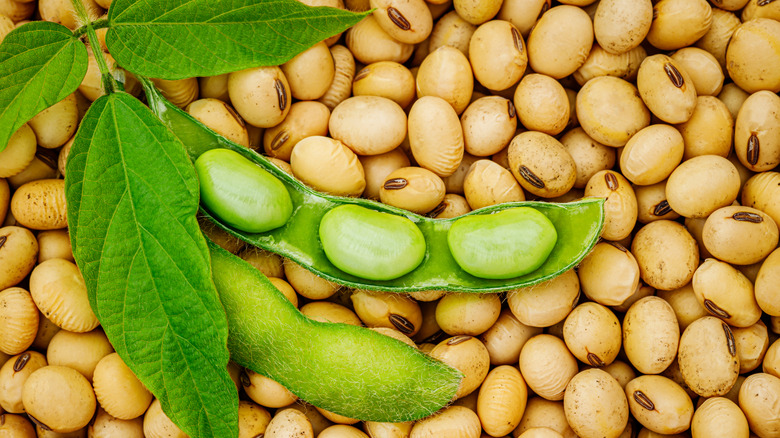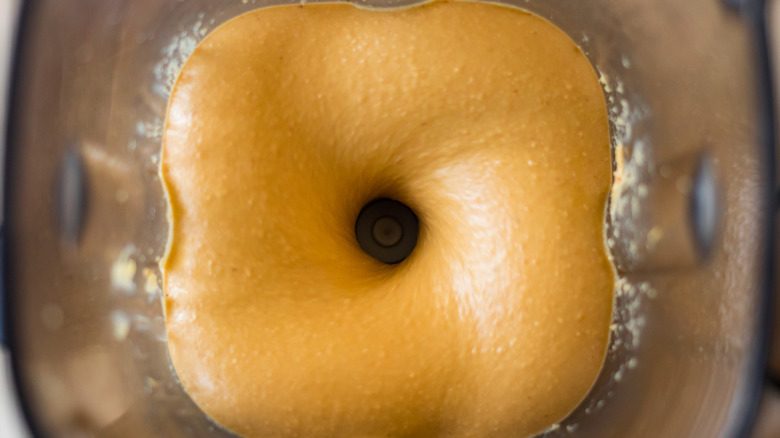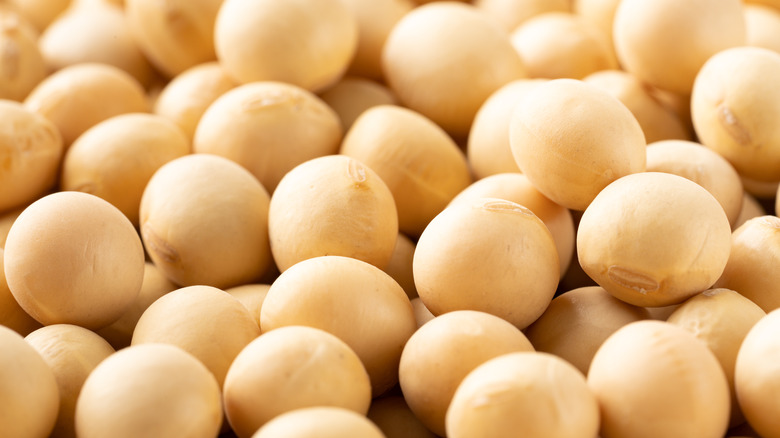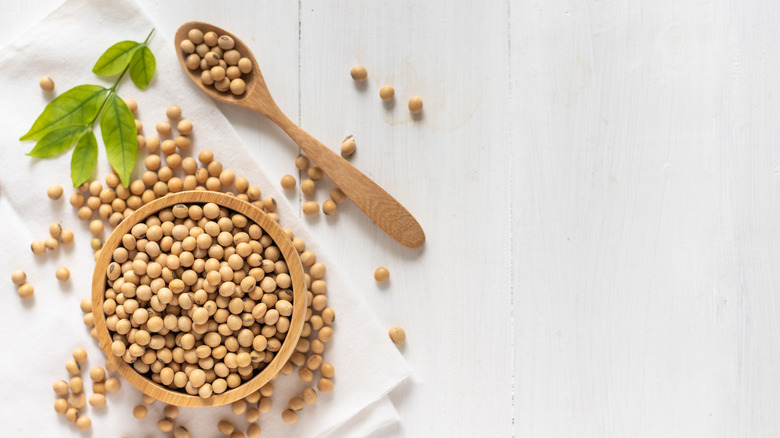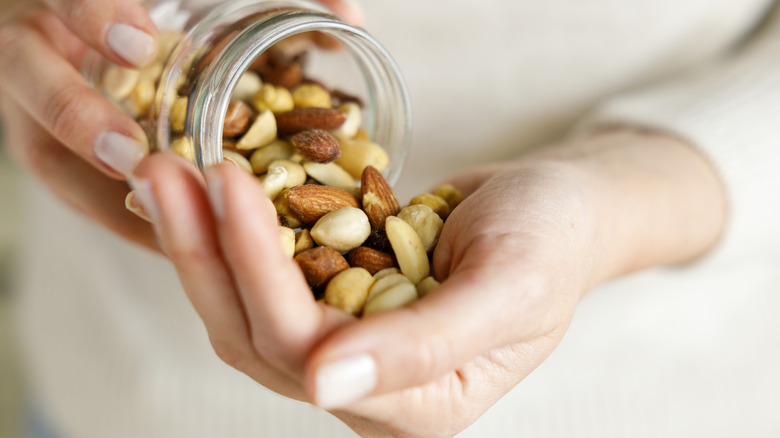How Is Soy Nut Butter Different From Other Varieties?
We may receive a commission on purchases made from links.
These days, the "PB" part of your PB&J could be replaced with any other acronym — whether it's an "AB" for almond butter or a "CB" for cashew butter, a walk down the designated aisle of any grocery store in the US will prove how endless your options are. Alas, being nut butters, very few of the peanut butter alternatives found on store shelves today are made with the nut-allergic in mind. Being the second most common allergy in children and affecting 1.6% of the general population — or 3 million people — in the United States, many of the options on the market today are either made with nuts or in facilities that also process peanuts. That leaves many people out of what should be an American right: the simple luxury of a good PB&J.
However, in the midst of the nut butter fiasco that has taken over the PB&J aisles of stores across the US, choosing the right nut butter for you can be difficult, but the nut-allergic can find a few saviors. Sunflower seed butter is one alternative that's been on the shelves for a while, as well as newer options like the oat-based granola butter jars from Oathaus, which come in various experimental flavors. However, there's another option out there that you may not have heard of — it's called soy nut butter, and it could be just the "SNB" your "J" has been looking for.
What is soy nut butter?
As you can probably guess by its name, soy nut butter is a peanut butter alternative made from a base of soybeans. But, despite its name, soy nut butter doesn't contain any nuts — making it a safe alternative for those of you experimenting with your nut-allergen-friendly PB&Js. Just like other types of nut butter, soy nut butter is made from a mix of roasted or unroasted soybeans, oil, and salt. While some may also contain homogenized oils like palm oil or added sugars, the texture is usually comparable to traditional peanut butter: thick and creamy, but always smooth.
Surprisingly, with a lovely, golden brown color, soy nut butter ends up looking a lot like peanut butter too. Also, because it's made from a legume with high protein content, soy nut butter comes with a very similar nutrition profile as peanut butter, and, in some categories, even outperforms it. The only catch is in its taste — which is arguably the most important. However, depending on your taste preference, you may end up liking soy nut butter and another person could not. Either way, it's good to have more nut butter options that everyone can enjoy, even if they may not actually contain any nuts.
How to make soy nut butter
Conventional soy nut butter can be purchased at the store; however, it can easily be made at home as well. Fortunately, if you've ever tried making other types of nut butter at home, making soy nut butter isn't much different. Plus, if you're someone who also makes your own soy milk at home, soy nut butter is a great way to reduce your waste and use up all that leftover nut pulp that gets left in your cheesecloth. All you need is some soy nuts, whether they're roasted, raw, or milked, your preferred oil — soybean oil is most commonly used, but you can use any neutral-tasting oil you have on hand — and salt.
Once you have all your ingredients, you can just throw them all in a blender and blend away. It might look like it's not working at first, but eventually, the soybeans will slowly break down into a smooth mixture — so give the beans about 10 minutes of blending time before adding additional oil. What's great about making your soy nut butter at home, though, is that you can customize the texture and flavors to your own taste. When you're making your soy nut butter, feel free to add more water or more oil for a runnier consistency or less for a thicker one. You can also mix in maple syrup, dates, or vanilla for sweetness, along with any seasonings such as nutmeg, cinnamon, pumpkin spice, or cardamon for a bit more fun.
What does soy nut butter taste like?
The one department that soy nut butter may or may not hit right for you is in flavor — but only because being made from a legume and not a nut, it tastes a lot different from peanut butter. This is neither a good nor bad thing and totally depends on the person. Some say that, compared to peanut butter, the taste of soy nut butter can come across as a bit stale. It's also been observed to have a bit of an aftertaste; however, that's nothing a good vanilla blackberry jam can't fix.
Flavor can also vary depending on the ingredient of the soy nut butter. Just like with other peanut butter substitutes, you can find soy nut butter made from roasted and unroasted soybeans, with the roasted variety having a much more pronounced flavor. Some brands may also contain different oils, which can also affect the taste. There's also the impact of the salt and sugar content of whatever brand you choose, which should all be taken into account when choosing which to buy.
Where to buy soy nut butter
As discussed before, you can easily make your own nut butter at home. While that does come with its own advantages, like the freedom to add whatever flavors and seasonings you like, it does mean that it may not last quite as long as the conventionally made soy nut butter you'd get from the store — so it doesn't hurt to keep one or two store-bought jars stocked for emergencies. Even though you might not always find the same fun flavors that the Oathaus granola butter comes in, you should be able to get your hands on a jar of soy nut butter online or in-store that will get the job done.
One of the more commonly found brands of soy nut butter is called Wow Butter. Their jars can be found at most of your local grocery stores using their store locator and are sold in different sizes — from travel-friendly to-go cups to 1 kilogram jars — and in both creamy and crunchy varieties, and are all made in a peanut-free environment. They can also be purchased online, either through the Wow Butter Website or Amazon.
Soy nut butter nutrition
Soy nuts, or soybeans that have been soaked, drained, and baked or roasted to make soy nut butter, have a lot of surprising health benefits. Besides being rich in plant-based protein — delivering the equivalent of peanut butter, with 7 grams per serving (via Live Strong) — the soy nuts in soy nut butter provide the added benefits of fiber and isoflavones. While most of you probably understand the benefits of fiber, which, according to the Mayo Clinic, include lowering your risk of diabetes and helping to maintain a healthy body weight, studies show that soy fiber has some other unique benefits.
While it's known that the isoflavones found in soy nuts act like antioxidants in your body and boost bone strength, studies , including one published in Molecular Nutrition and Food Research, have also found that they actually work in synchronicity with the plant-protein and fiber content of soy nuts to boost the legume's metabolism benefits. In addition to the fiber and isoflavones found in soy nut butter, the peanut butter alternative also contains rich amounts of healthy unsaturated fats, vitamins, and minerals, including calcium and iron.
Roasted soy nut butter vs. raw
As with other kinds of nut butter, you may stumble across jars of "roasted" varieties and raw varieties of soy nut butter — and, just like whichever other type of peanut butter alternative you use, the difference between "raw" and "roasted" is essential to understand. In recent years, the raw food movement has perpetuated a false narrative around cooked foods, leading some people to believe that uncooked and unprocessed foods are far healthier than foods that have been cooked or, in the nut butter scenario, roasted. While it might be true that some foods lose nutrients when cooked, cooking can also add nutritional benefits to your food while making it easier to digest and, often, tasting better.
Now that the serious stuff is out of the way, your decision between "roasted" and "raw" soy nut butter can be based on a more logical point of view: the taste differences and best uses for each. Roasted varieties of soy nut butter tend to have a much more pronounced, rich, and toasty flavor compared to the raw varieties. They're recommended to be used in scenarios where their flavors can shine, such as on toast, crackers, as a topping on oatmeal, smoothie bowls, or, of course, your peanut butter and jelly sandwiches. On the other hand, raw soy nut butter would be better in use for dips, sauces, or soups. Either is suitable for baking, but you should follow what your recipe says.
